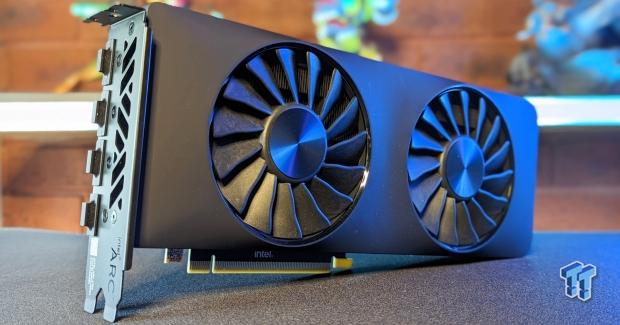The Bottom Line
Pros
- + 1080p and 1440p performance with striking distance of the GeForce RTX 3060
- + More affordable than the competition
- + Surprisingly decent ray-tracing performance
- + Intel XeSS is an impressive DLSS alternative
Cons
- - In some tests, it barely matches the GeForce RTX 3050
- - Requires Resizable BAR enabled for best performance
- - Some minor issues when running certain titles and benchmarks
- - 8GB of VRAM compared to the RTX 3060's 12GB
Should you buy it?
AvoidConsiderShortlistBuyIntroduction
A third player in the discrete GPU market, it's been something we've wanted to see for years. That ideal is coming true (in part) thanks to Intel joining NVIDIA and AMD to offer an alternative in the entry-level and mid-range market. But, the debut of Intel's Arc A750 and A770 graphics cards in late 2022 was met with a mixed reception, so we're not quite at the point where the big three are going head-to-head to win over consumers.
With Intel continuing to release new drivers that improve Arc performance and new generations of Intel Arc on the way, we could be at that place pretty soon. Intel's Arc A750 and A770 graphics cards launched in October of last year, and if you paid any attention to reception, you'd recall that both GPUs felt more like 'first go's' than products from a company releasing its fourth or fifth or tenth GPU generation.
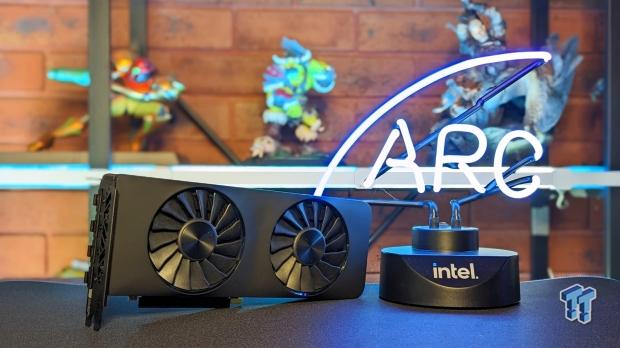
Teething issues is the best way to put it, with performance varying wildly depending on the game, engine, and graphics API used. The consensus was that Intel's new GPUs performed better with games running on DirectX 12 versus DirectX 11 or something more archaic like DirectX 9.
The good news is that drivers have matured quite a bit since October, with Intel releasing several milestone updates for the Intel Arc range promising substantial improvements to in-game performance. Coupled with price drops, we now have the Intel Arc A750 available for around USD 249, so you've potentially got a great entry-level option.
And this is every bit an Intel Arc A750 Limited Edition review for May 2023, using the latest Intel Graphics Driver from late April. How does it stack up against the GeForce RTX 3060, which can cost upwards of USD 100 more? According to Intel, on average, it outperforms NVIDIA's mainstream RTX 30 Series option in 1080p and 1440p gaming.
Above all, though, what's it like to game with a non-NVIDIA or non-AMD GPU? Strange at first and a little temperamental and spotty, but overall impressive. Let's dig in.

Intel Alchemist Enters the Race
Below is a summary of the Intel Arc technology, applicable to all models.
The debut of the Intel Arc A750 and Intel Arc A770 graphics cards for desktops in 2022 marked Intel's arrival into the discrete GPU space. Not only that, but the appearance of new architecture from Intel designed for gaming, creation, and AI applications called Xe HPG - with that last bit standing for High-Performance Computing. Like NVIDIA and AMD, Intel has spent the time and resources to develop its own Xe HPG graphics architecture with an approach that features some genuinely new ideas that deliver scalability from laptops up to high-end desktops.
Compared to the single measure of NVIDIA's CUDA Cores and AMD's Compute Units, Intel's Xe HPG architecture breaks down its technological blocks into 'Render Slices' - with each one containing four Xe Cores, four Ray Tracing Units, and the general building blocks of what make up a modern-day GPU. As brand-new architecture, Xe HPG has been built from the ground up with DirectX 12 Ultimate in mind, meaning that all Arc-based GPUs can handle the challenging task of real-time ray-tracing and use DX12 features like Variable Rate Shading and other bits of rendering technology.

Xe HPG architecture is built for AI, with dedicated AI hardware ala NVIDIA's Tensor Cores in the GeForce RTX range. Each Xe Core (there are four of these in each 'Render Slice') features hardware built for traditional rasterization tasks but also Intel Xe Matrix Extensions (Intel XMX) Engines capable of handling machine-learning tasks. This directly ties into Intel's XeSS rendering, which like DLSS, uses AI to upscale. However, it isn't exclusive to Intel Arc GPU hardware; it is AI-based and benefits from Intel's accelerated machine learning via the Intel Arc series, but it is designed to work on all GPUs.
As mentioned above, each 'Render Slice' also features dedicated ray-tracing hardware. Beyond this, there's a unique Thread Sorting Unit designed to help with efficiency and be able to do other tasks simultaneously to improve RT and other performance.
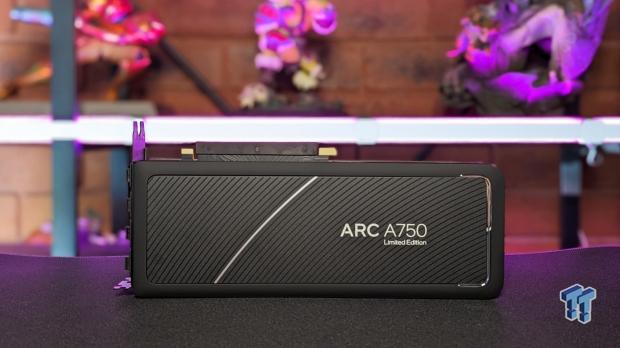
A shared cache can also be used for any compute workload, shading task, or in-game texture-related thing. And for creators, the Xe media engine offers hardware-accelerated AV1 encoding with support for encoding and decoding up to 8K with VP9, AVC, HEVC, or AV1.
As a brand-new piece of architecture, Intel has designed Xe HPG for modern-day gaming and graphics card usage. From playing visually stunning titles with ray-tracing, competitive shooters like CS: Go, or simply watching or even streaming content - it's all here, including support for DisplayPort 2.0.
Specs and Test System
Specifications
As a brand-new GPU line-up from Intel, specs-wise, you can only compare the Intel Arc A750 to the more powerful Intel Arc A770. As per the image below, the main takeaway is that you've got a modest increase in specs between the two variants, with the big difference being the Intel Arc A770's 16GB of VRAM - which is impressive considering that VRAM capacity is currently a hot topic in the GPU space.
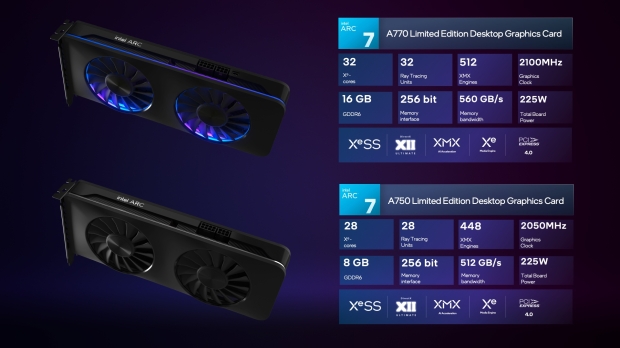
The Intel Arc A750 Limited Edition features 8GB of VRAM, the current standard for entry-level and mid-range GPUs, though it's less than the 12GB offered by most GeForce RTX 3060 models. With 50% more VRAM, the RTX 3060 might look more attractive, but the Intel Arc A750 is notably cheaper in pricing, and its price is closer to the GeForce RTX 3050 than the GeForce RTX 3060.
The Intel Arc A750 uses Intel's new Xe HPG architecture explicitly built for gaming and content creation. If the specifications below are confusing, read the summary of Intel Arc technology above.
- GPU: Intel Arc A750 Graphics
- Model: Intel Arc A750 Graphics Limited Edition
- Interface: PCI Express 4.0
- Microarchitecture: Xe HPG
- Render Slices: 7
- Xe-cores: 28
- Ray Tracing Units: 28
- Intel Xe Matrix Extensions (Intel XMX) Engines: 448
- Xe Vector Engines: 448
- Graphics Clock: 2050 MHz
- Memory: 8GB GDDR6
- Memory Speed: 16 Gbps
- Memory Interface: 256-bit
- Total Memory Bandwidth: 512 GB/s
- Display Connections: 1 x DisplayPort 1.4, 1 x DisplayPort 2.0, 1 x HDMI 2.1, 1 x HDMI 2.0b
- TBP: 225W
- Recommended PSU: 600W
- What's in the Box: Intel Arc A750 Graphics, Welcome Card, Quick Start Guide
Kosta's Test System
- Motherboard: MSI MPG X670E Carbon Wi-Fi
- CPU: AMD Ryzen 9 7900X
- Cooler: Corsair iCUE H100i RGB PRO XT Liquid CPU Cooler
- RAM: 64GB (2x32GB) Corsair DOMINATOR PLATINUM RGB DDR5 DRAM 5200MHz
- SSD: Sabrent Rocket 4 Plus-G M.2 PCIe Gen 4 SSD 4TB, Sabrent Rocket 4 Plus Plus M.2 PCIe Gen 4 SSD 8TB
- Power Supply: Thermaltake Toughpower GF1 850W
- Case: Thermaltake Core P3 Tempered Glass Snow
- OS: Microsoft Windows 11 Pro 64-bit
Physical Design and Cooling
The Intel Arc A750 Limited Edition is Intel's reference card, its Founders Edition. The two-slot enclosed design is small by modern standards and excellent for entry-level and mid-range GPUs. Placed next to most GPUs with two or three-fan designs, and it's relatively tiny. But it's also stylish, minimal, and weighty- with a solid feel built to last. The matte-black rubbery finish on the front might not be for some, but it's something that I loved the look of when installed in my test system.
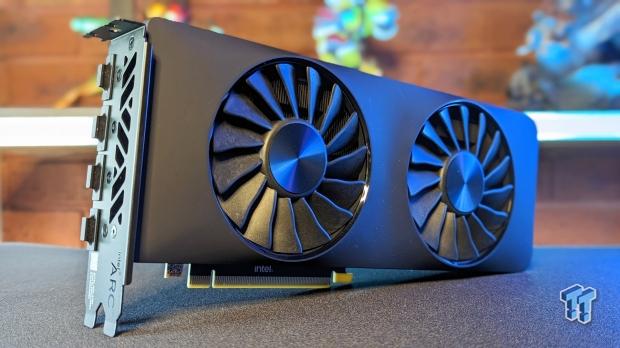
The all-black design and lack of RGB on the front is another great touch, and the back plate features the model name and arc patterns with some slightly shiny metal. Outside of aesthetics, you've got a dual-fan cooler, heat pipes, and an aluminum heatsink in an overall clean package that covers the GPU die built on TSMC's 6nm process.
Although the cooling is relatively unnoticeable when idle, the Intel Arc A740 isn't an entirely silent GPU that has the fans turned off when you're not gaming and simply browsing the web - something that we've gotten used to thanks to the most recent generations of graphics hardware from NVIDIA and AMD.
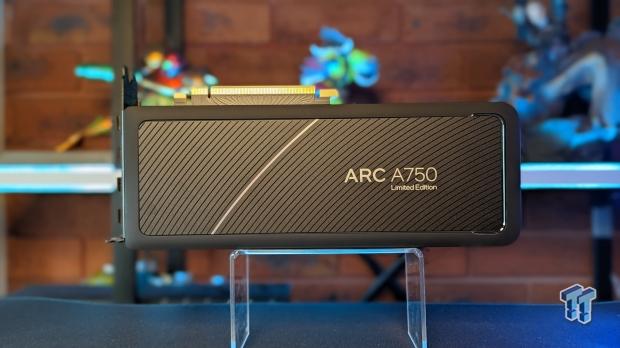
Even so, the idle temperatures are similar to what you'd find on mainstream GPUs from the RDNA 2 and Ampere generation, sitting below 50 degrees mostly, with fans only really kicking in when gaming. Under full load, the Intel Arc A750's temperature sat at around 72 degrees with a 76-degree hotspot with the fan speed running at 1743 RPM - noticeable but not noisy. Power usage hovered at under 200W, which was also good to see.
Benchmarks - 15 Game Averages
The Games and Tests
In 2023 PC gaming is a complicated and varied space, from indie games to major blockbuster releases and titles that push hardware and technology to their limit with the adoption of effects like real-time ray-tracing.
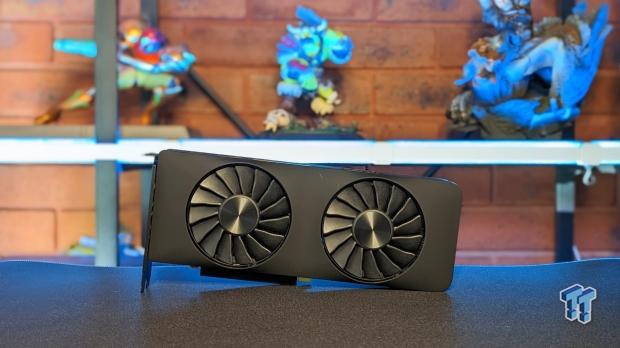
This is all a way of saying that the 15 in-game benchmarks we've chosen (and run at 1080p and 1440p) represent a wide range of styles, not only in terms of genres, like first-person shooters and racing games, but also in the API technology (DirectX 11, 12) and cutting-edge features like ray tracing and upscaling technology.
Where possible, results include Intel XeSS and AMD FSR 2, as both technologies are the sorts of things you'd turn on to boost performance. Six of the 15 games benchmarked feature ray tracing, a great way to see how Intel's architecture handles the cutting-edge and technically intensive rendering form. Also, each title is set to ultra-equivalent quality settings to push GPU hardware and minimize CPU bottlenecks at higher resolutions.
Also, it's just fun to max out a game's visual settings and see the results. Here's the breakdown of games, graphics settings, and what's being tested.
And with 15 games, a special shoutout goes to Sabrent for providing us with the storage to ensure we can keep everything installed - and then some - with both the Sabrent Rocket 4 Plus-G M.2 PCIe Gen 4 SSD 4TB and Sabrent Rocket 4 Plus Plus M.2 PCIe Gen 4 SSD 8TB offering exceptional performance, capacity, and reliability.

We can keep all our benchmark software installed while also installing every new game release that comes our way.
- Assassin's Creed Valhalla: Ultra High-quality settings, with the in-game benchmark tool used.
- Borderlands 3: Ultra quality settings, with the in-game benchmark tool used.
- Call of Duty: Modern Warfare II: Ultra quality setting, in-game multiplayer benchmark tool used.
- Cyberpunk 2077: Ultra quality setting, in-game benchmark tool used. AMD FSR and NVIDIA DLSS results are included.
- Cyberpunk 2077 (RT): Ray tracing Ultra quality setting, in-game benchmark tool used. AMD FSR and NVIDIA DLSS results are included.
- DOOM Eternal (RT): Ultra Nightmare quality setting with ray-tracing enabled, the opening of Mars Core campaign level used to benchmark.
- F1 22 (RT): Ultra High-quality setting with ray tracing, one lap of the Bahrain track benchmarked. AMD FSR and NVIDIA DLSS results are included.
- Forza Horizon 5 (RT): Extreme quality setting with ray tracing enabled, in-game benchmark tool used. AMD FSR and NVIDIA DLSS results are included.
- Hitman (RT): Ultra-quality settings with ray-tracing, Dubai scene benchmarked. AMD FSR and NVIDIA DLSS results are included.
- Horizon Zero Dawn: Ultimate quality setting, in-game benchmark used.
- Marvel's Guardians of the Galaxy (RT): Ultra quality setting with ray tracing enabled, the in-game benchmark tool used.
- Rainbow Six Extraction: Ultra quality settings and in-game benchmark tool used.
- Red Dead Redemption 2: Maximum quality settings, with in-game benchmark tool used. AMD FSR and NVIDIA DLSS results are included.
- The Division 2: Ultra quality settings with in-game benchmark tool used.
- Total War: Warhammer III: Ultra-quality settings with the in-game Battle Benchmark tool used.
15 Game Average FPS - 1080p Results
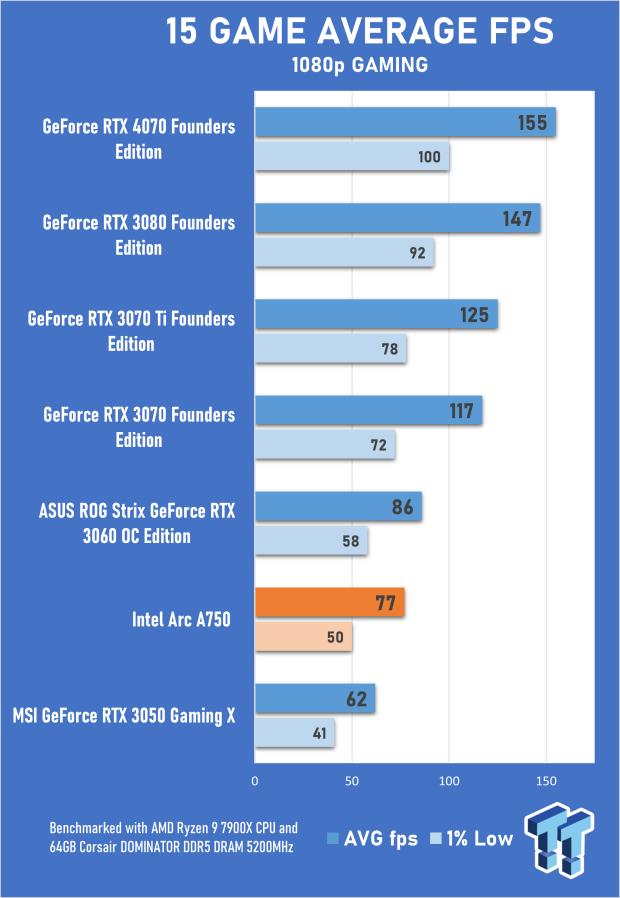
The Intel Arc A750 certainly delivers when it comes to 1080p performance, especially when you're talking about tests and benchmarks maxing out settings. But, with our pool of games, you can see that when it comes to average frame rates, the Intel Arc A750 sits between the GeForce RTX 3050 and the GeForce RTX 3060.
Here the Intel Arc A750 is roughly 10% slower on average than the GeForce RTX 3060 while being approximately 24% faster than the GeForce RTX 3050. That said, it's a lot more nuanced than that because individual game performance is inconsistent, with the Intel Arc A750 outperforming or matching the GeForce RTX 3060 in multiple games and then falling behind the GeForce RTX 3050 in others. You can see all that data in the individual game charts below, which I'll go into more detail in the benchmark summary later.
15 Game Average FPS - 1440p Results
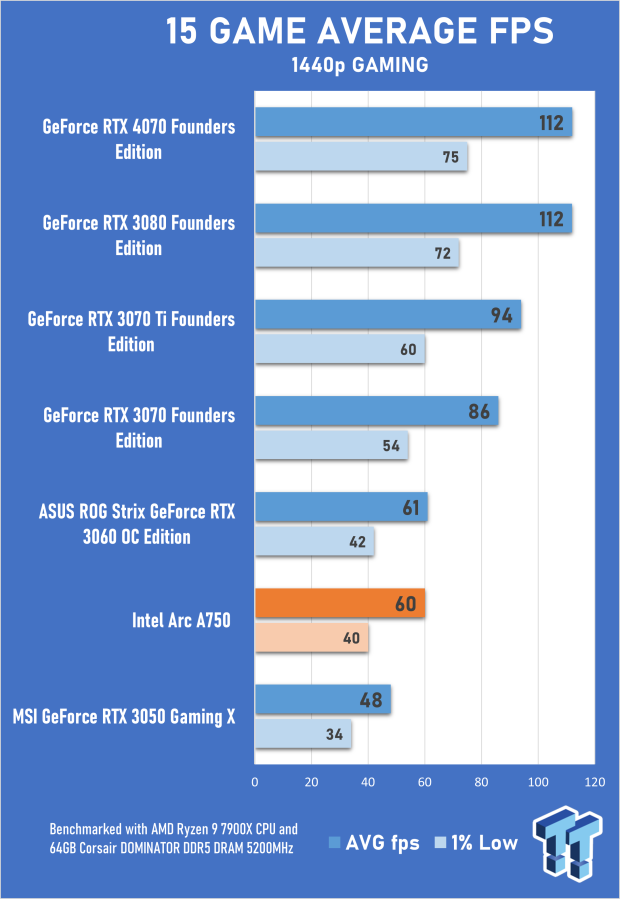
The Intel Arc A750 is still a capable performer in 1440p gaming, with the drop off when jumping from 1080p sitting at only 22%. Here we see the Intel Arc A750 matches the GeForce RTX 3060's overall performance with a 1 frame difference within the margin of error. Here Intel's GPU also outperforms the GeForce RTX 3050 by a considerable margin - 25%.
Like with the 1080p results, we see a decent 1% low performance, which is excellent. Performance is more than hitting a specific frame-rate target, as things like stutters or random drops can adversely affect how a game plays and feels. According to early reviews for the Intel Arc series, this was an issue in some titles, so it's good to see that's not the case and Intel is in step with the competition in this regard.
Benchmarks - 3DMark FireStrike
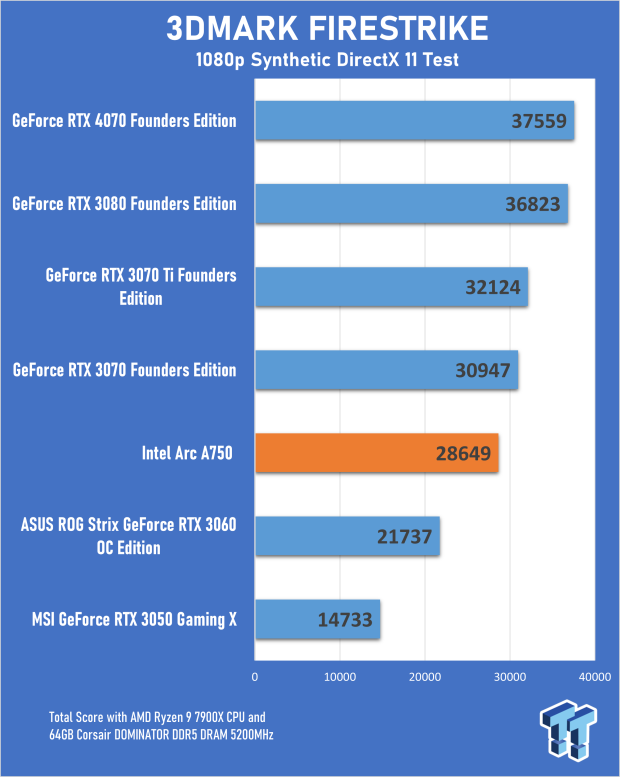

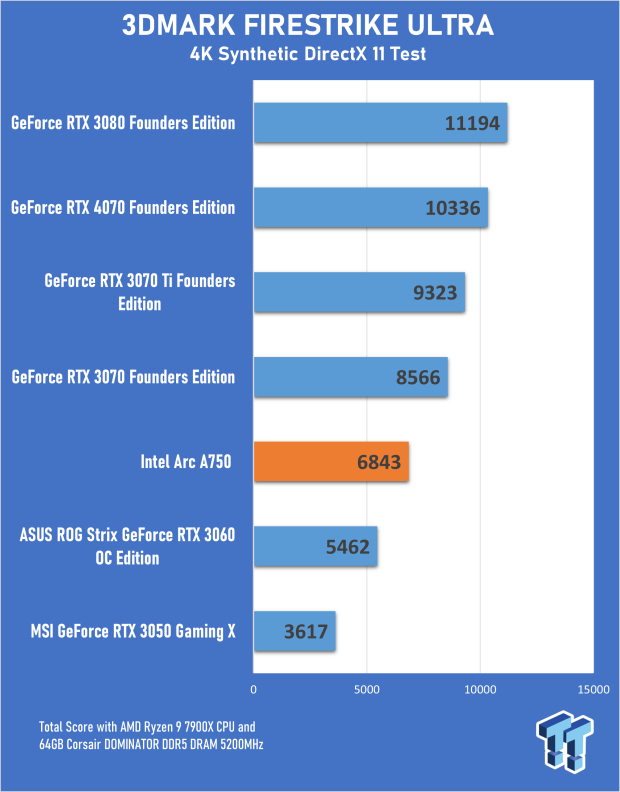
Okay, this is where things get a little strange - and solidify the thinking that even though Intel has made great strides toward more consistent performance for the Intel Arc range - cards like the Arc A750 are performing below their potential. Meaning there's probably some more untapped power sitting there somewhere.
3DMark FireStrike is a DirectX 11 test that has been around for many years and covers quite a large portion of games released over the past decade - at least in terms of the API and graphics technologies used. The three tests cover the resolutions - 1080p, 1440p, and 4K. And looking at the results for the various resolutions, the synthetic 3DMark FireStrike benchmarks showcase performance between the GeForce RTX 3060 and GeForce RTX 3070 - closer to the latter. Our 15-game averages and individual results below do not reflect this result.
Benchmarks - 3DMark TimeSpy and Port Royal
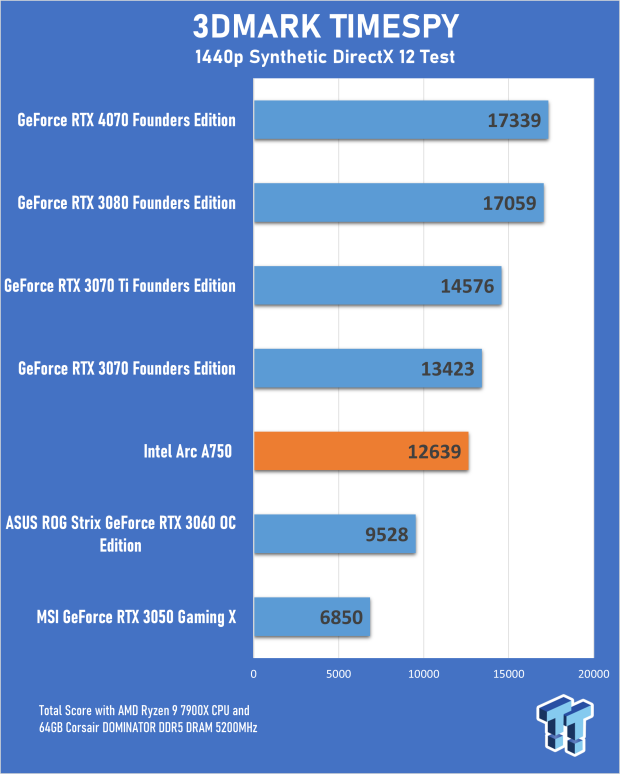
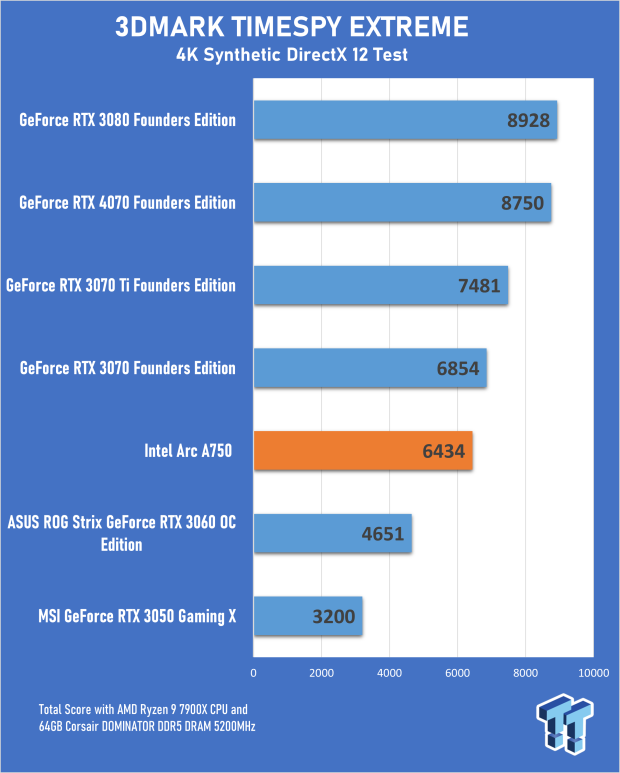
With 3DMark TimeSpy being DirectX 12-based, it's a more relevant synthetic benchmark for modern games. And potentially the Intel Arc A750, whose architecture was designed with DirectX 12 in mind. Like what we saw with the 3DMark FireStrike results, the numbers here sit below the GeForce RTX 3070 - even in the more intensive 4K-based TimeSpy Extreme. Again, this is not indicative of actual in-game performance.
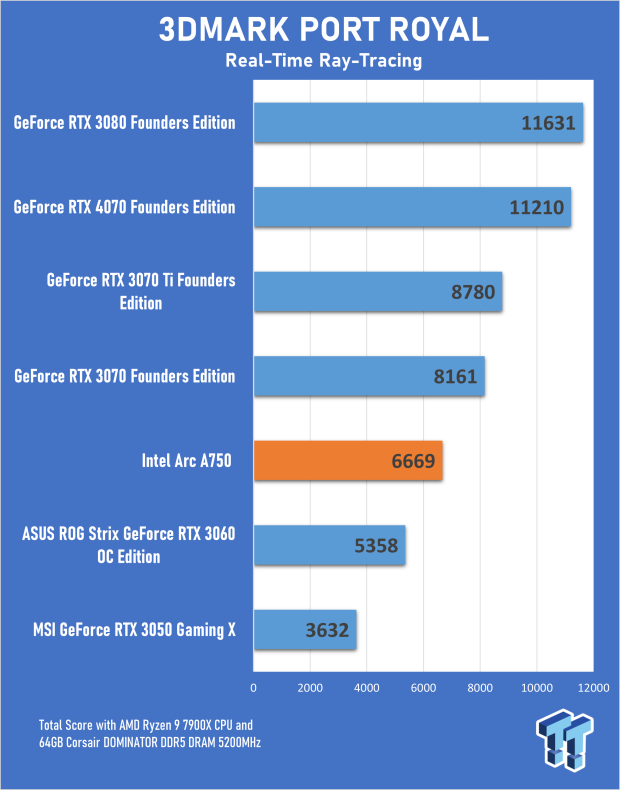
3DMark Port Royal is a synthetic ray-tracing benchmark, another result where the Intel Arc A750 comfortably outperforms the GeForce RTX 3060. But this is one result that makes more sense. When you look at ray-tracing-intensive titles like Hitman and Cyberpunk 2077 - two titles where NVIDIA hardware has always been the clear winner when cranking the RT effects - the Intel Arc A750 outperforms the GeForce RTX 3060 by a decent margin.
Benchmarks - 1080p Gaming
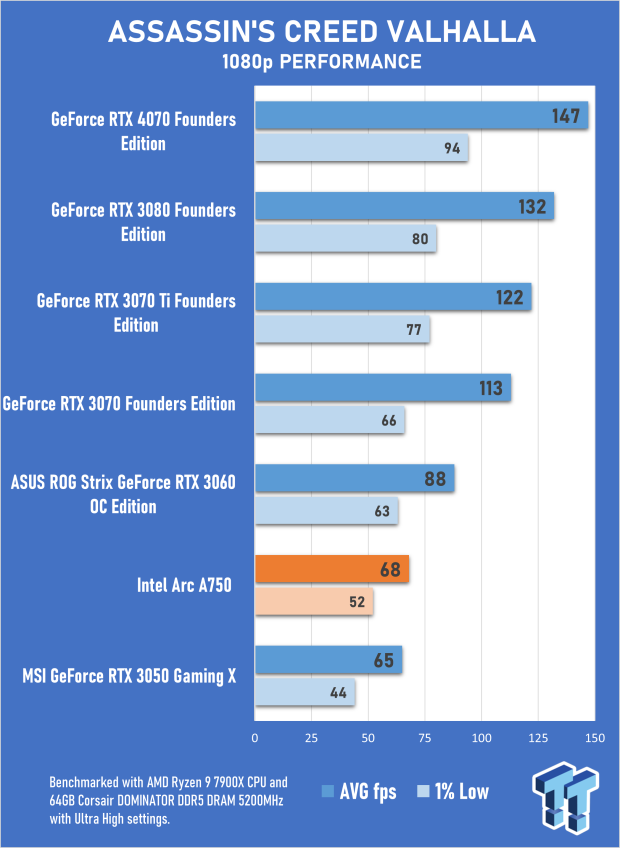
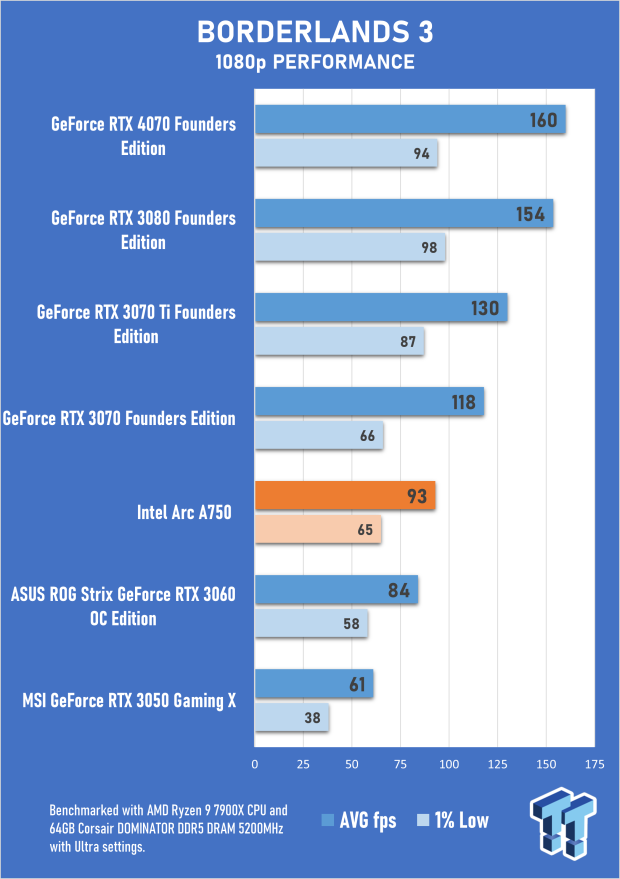

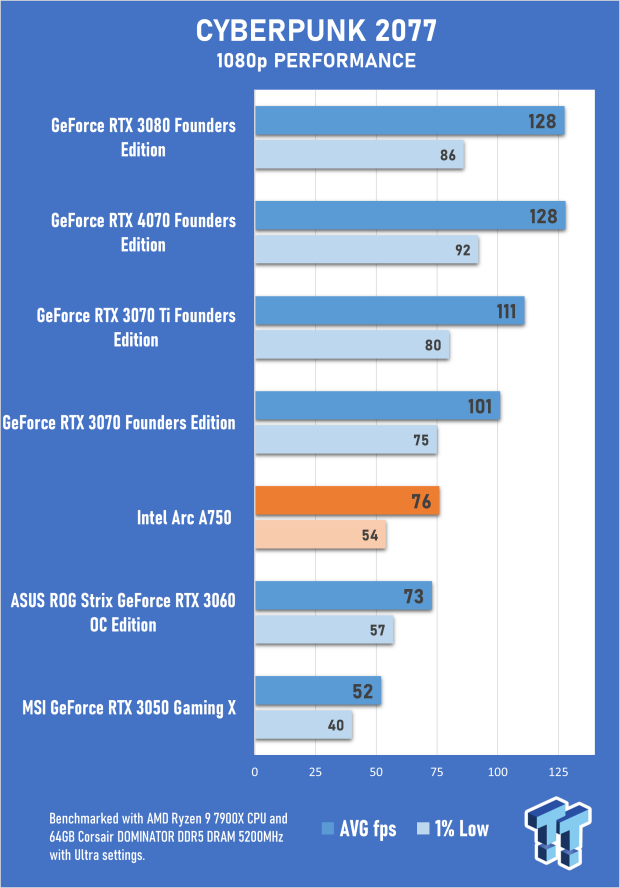
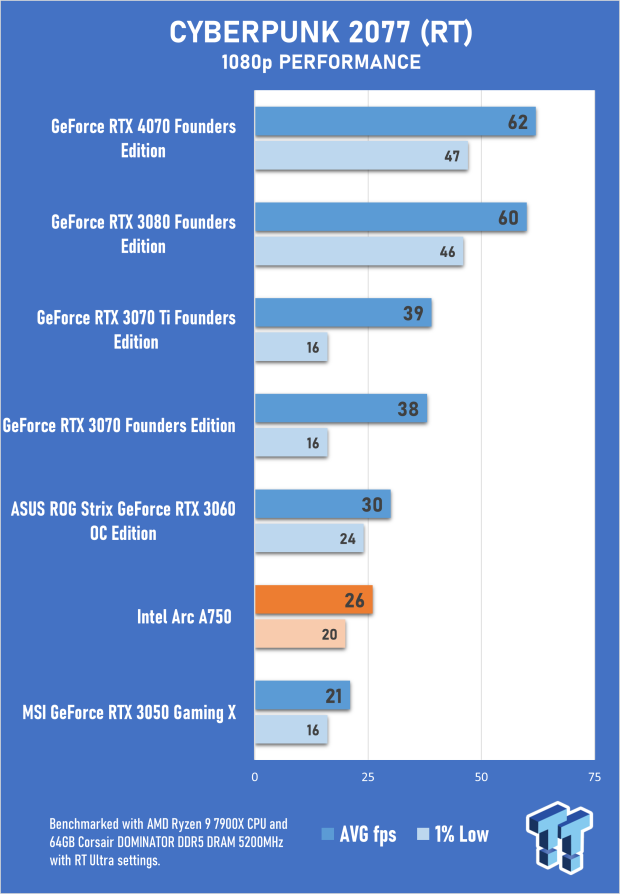
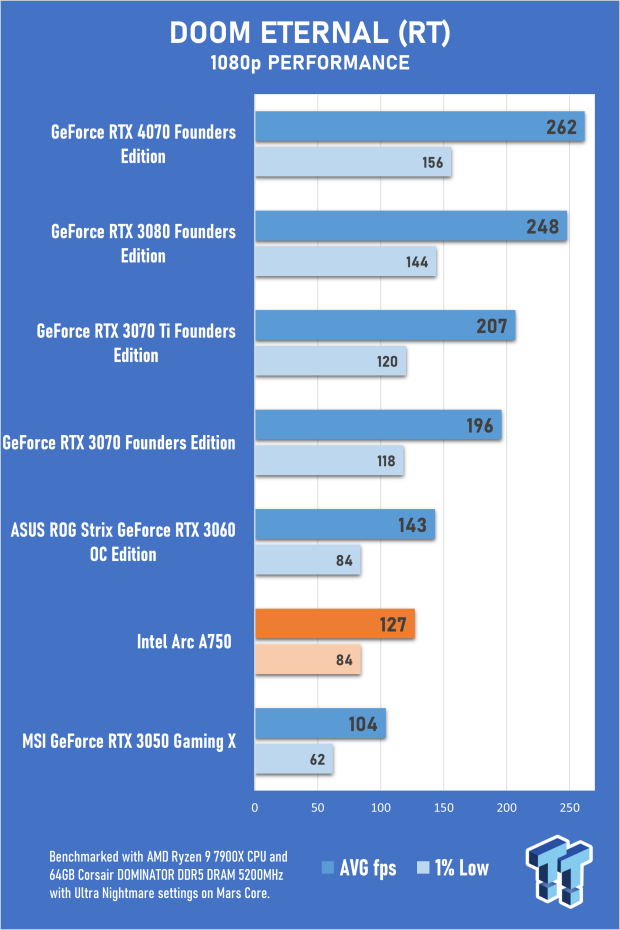
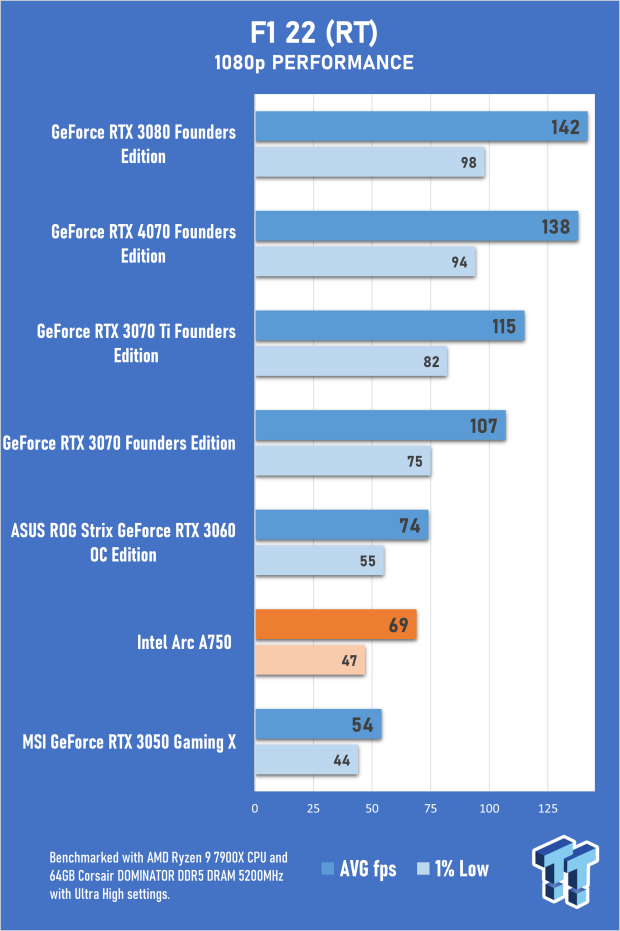
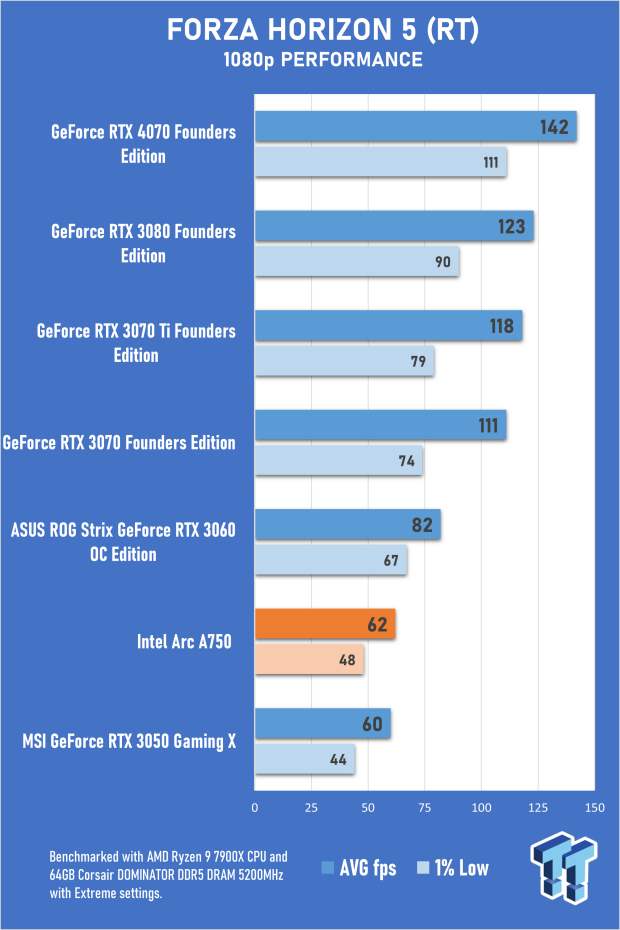
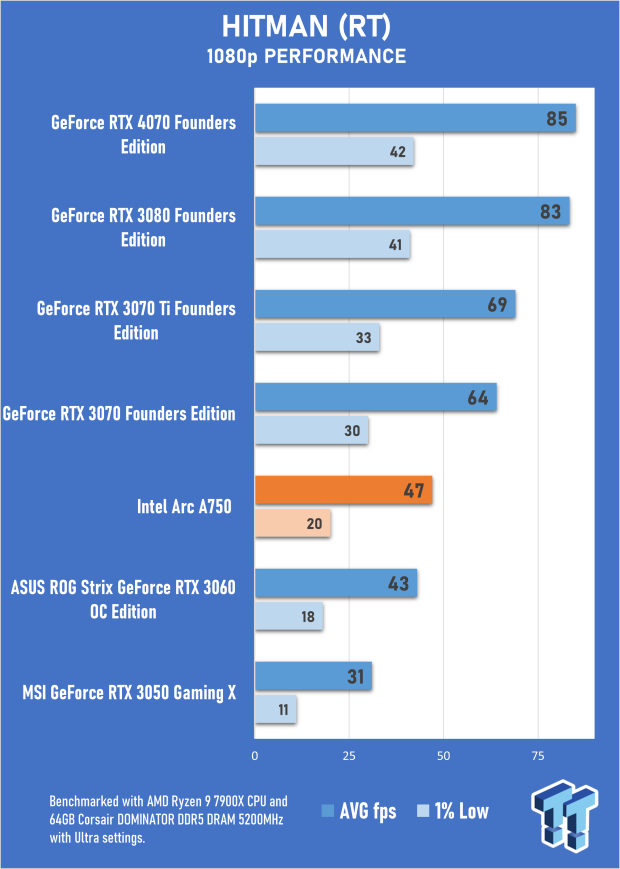
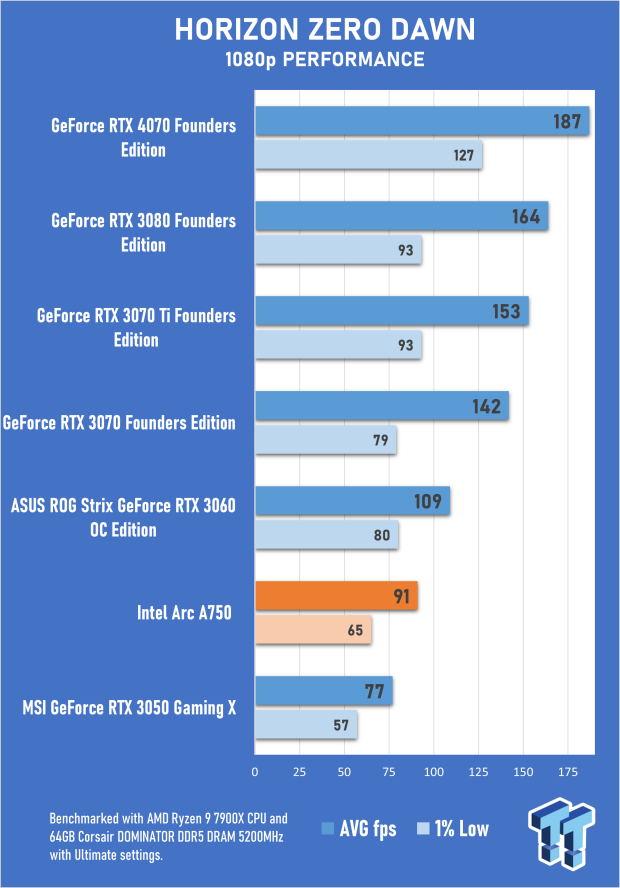
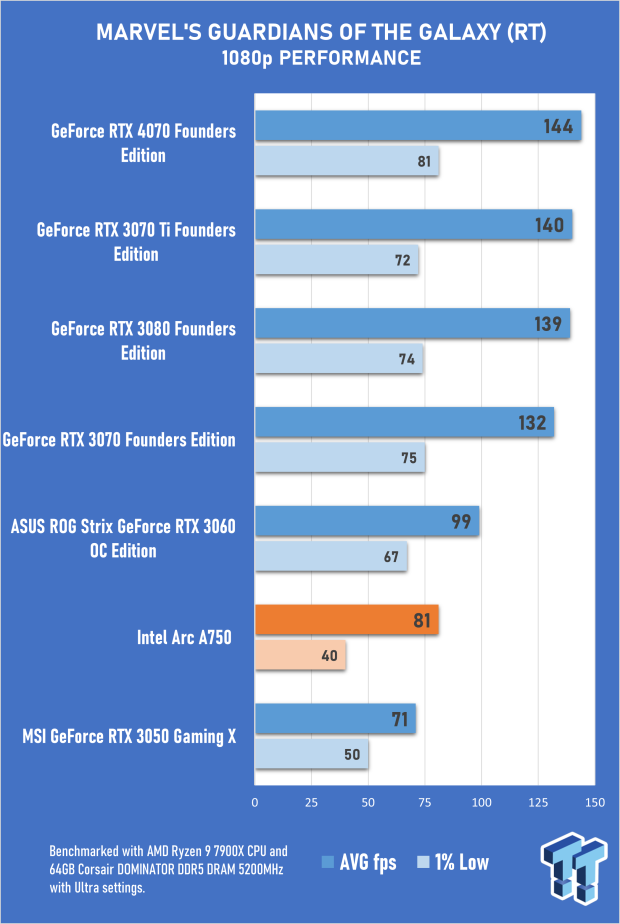
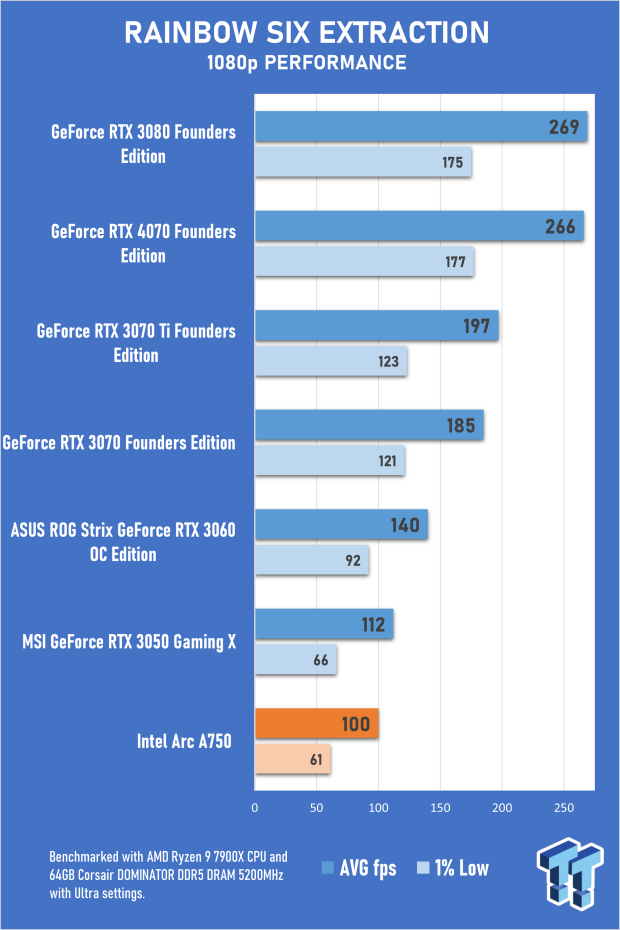
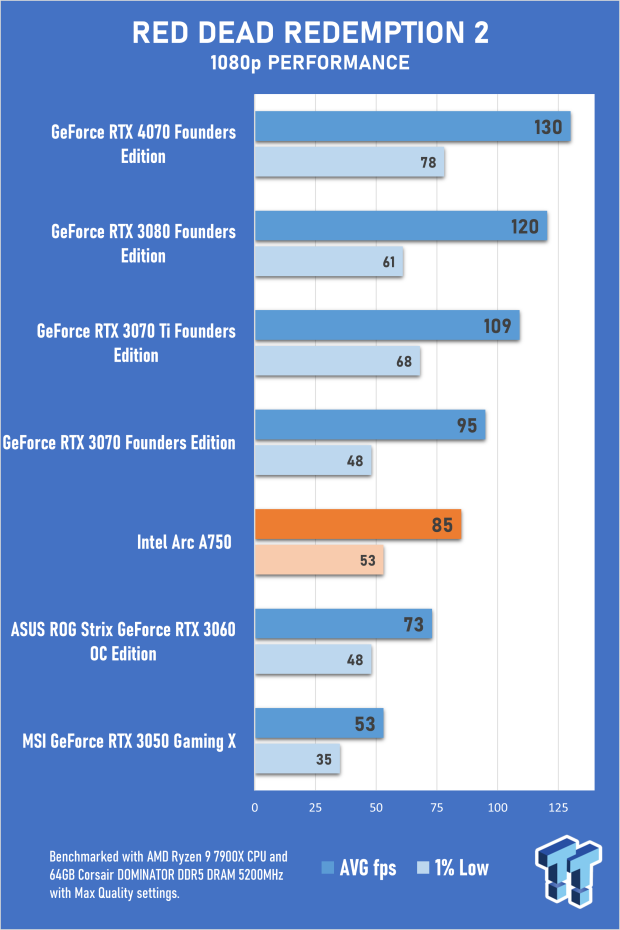
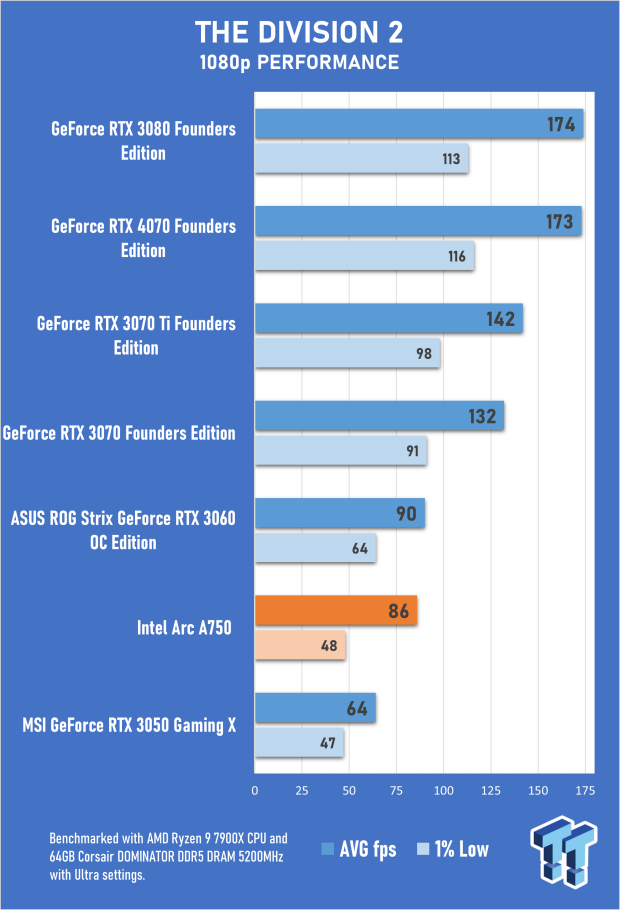
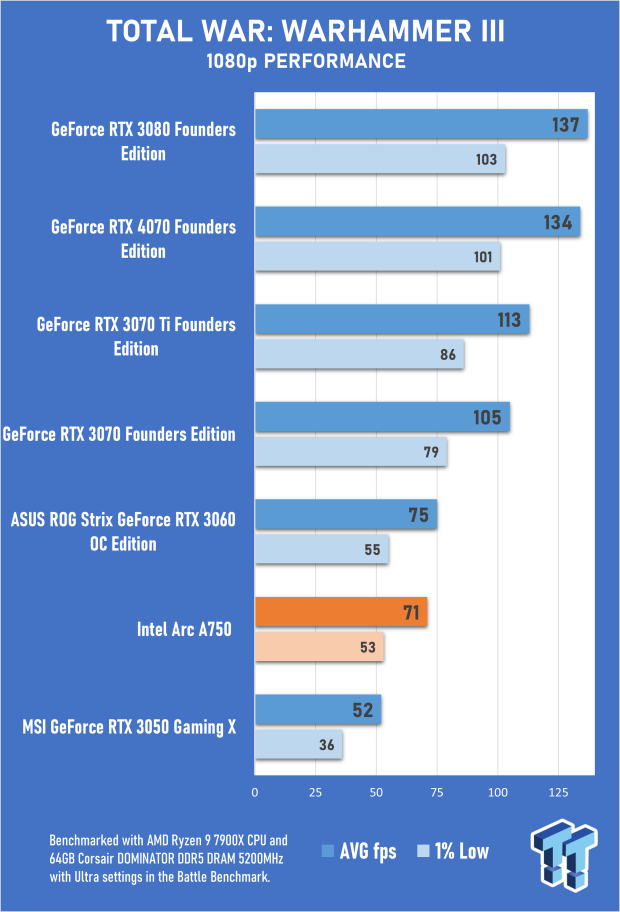
Benchmarks - 1440p Gaming
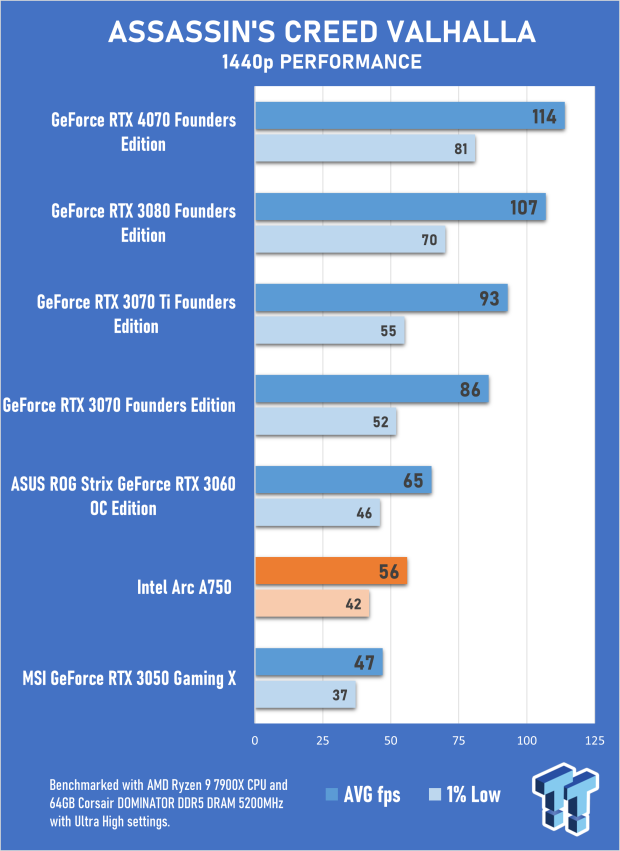
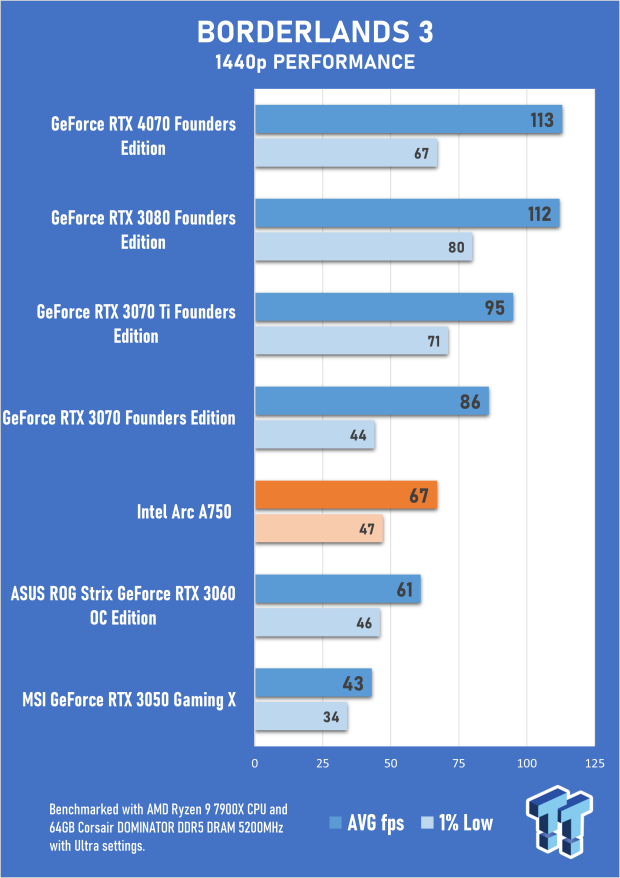
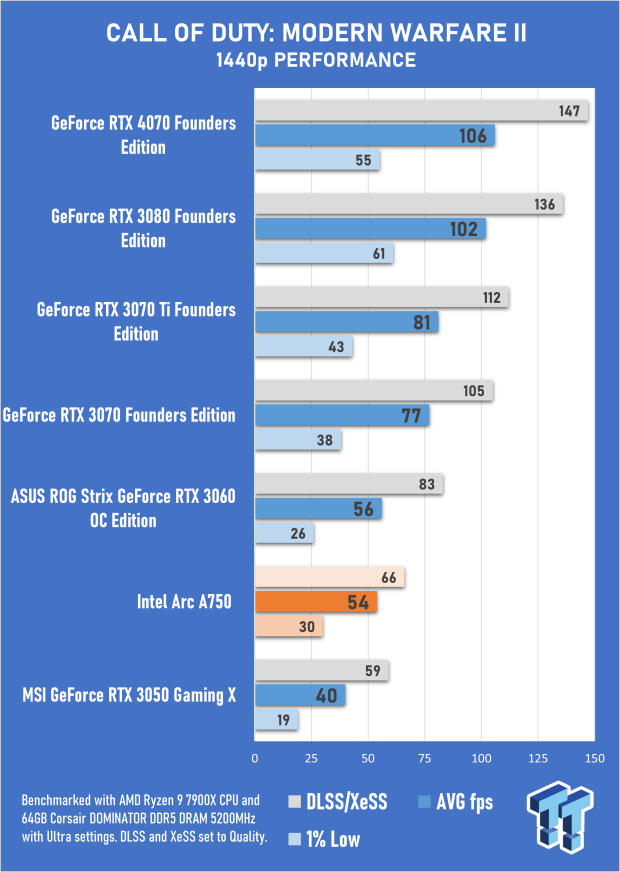
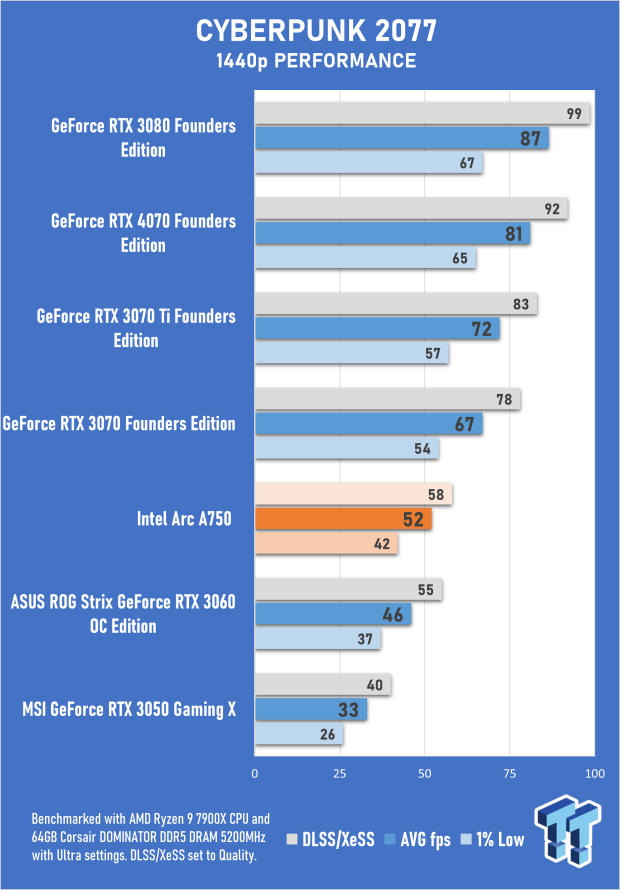
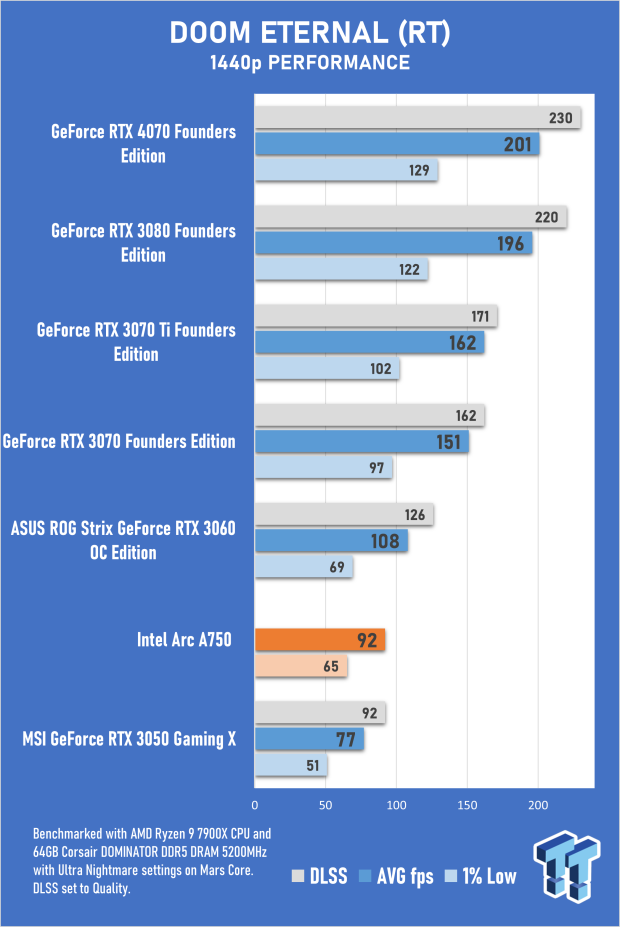
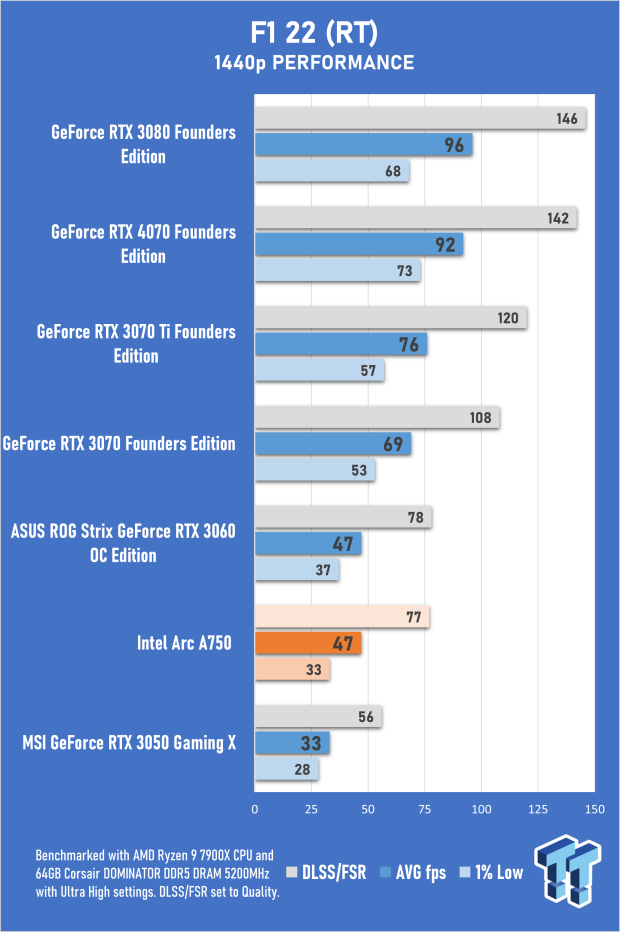
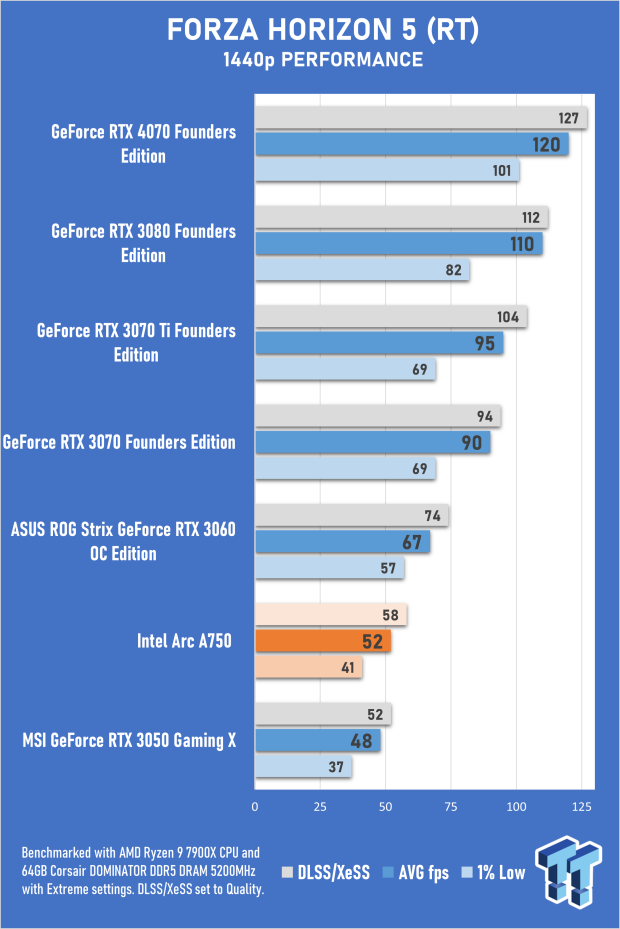
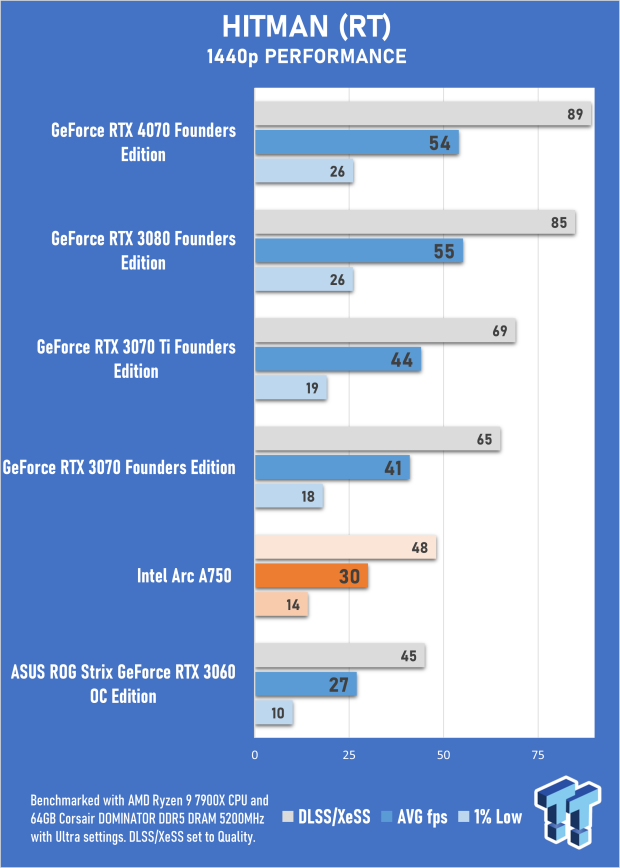
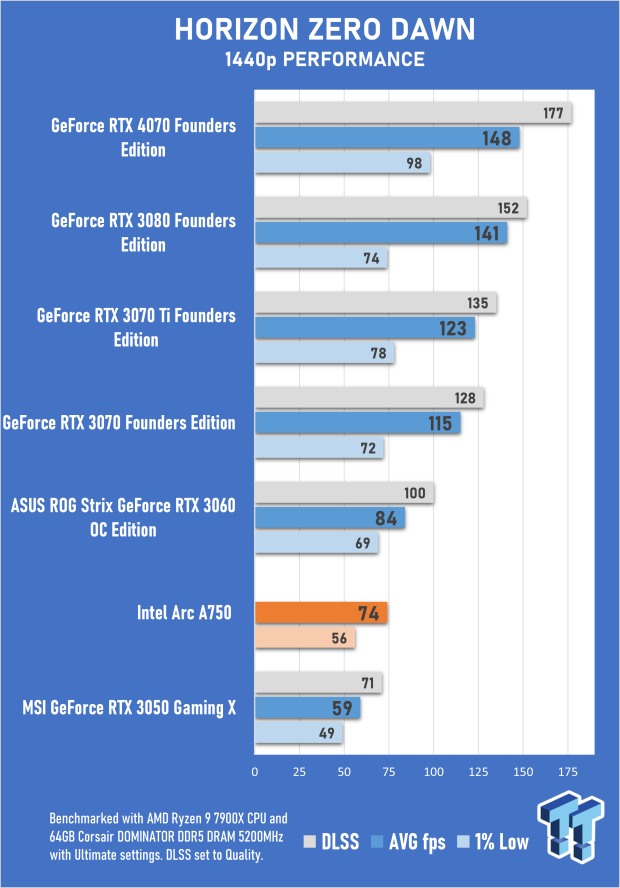
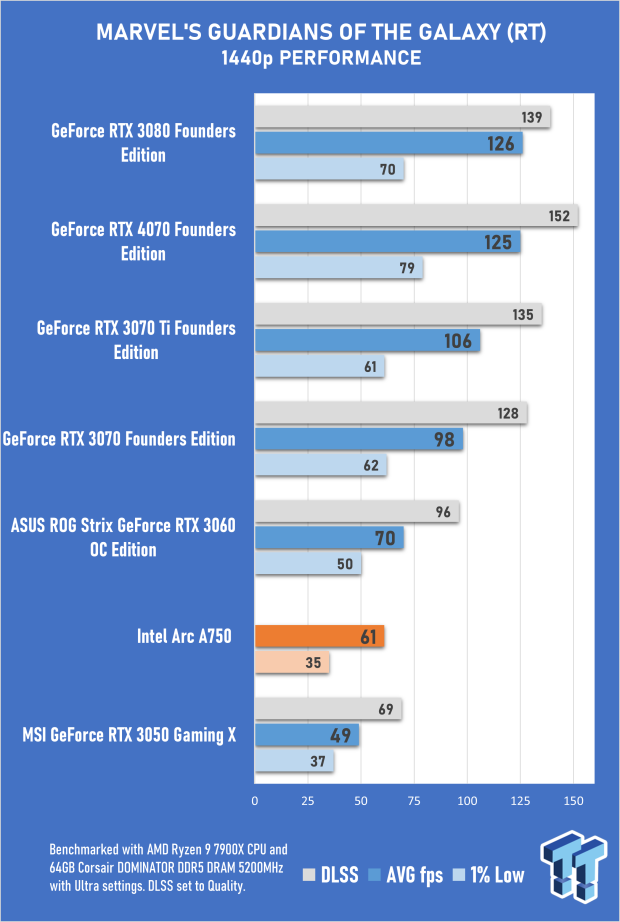
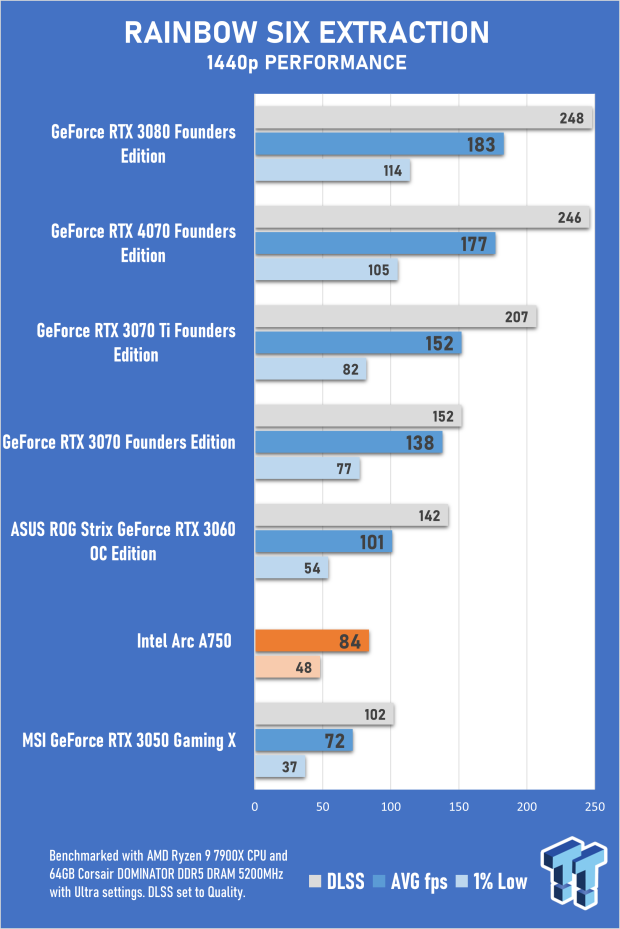
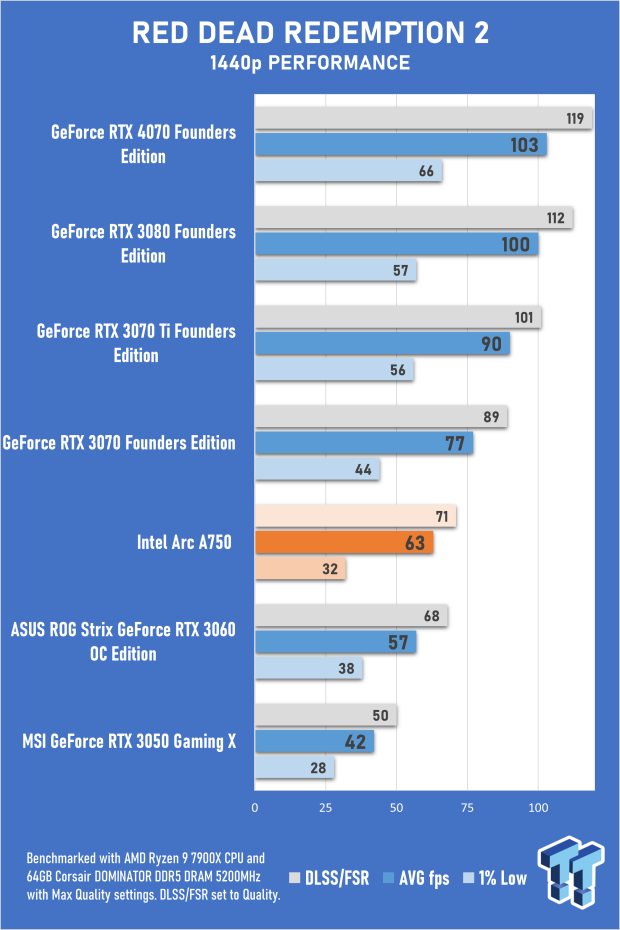
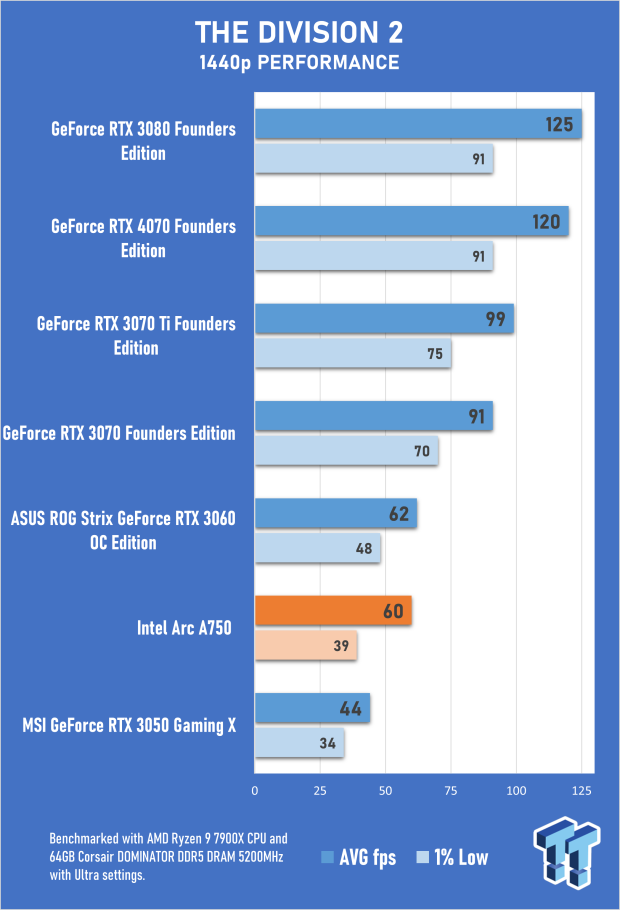
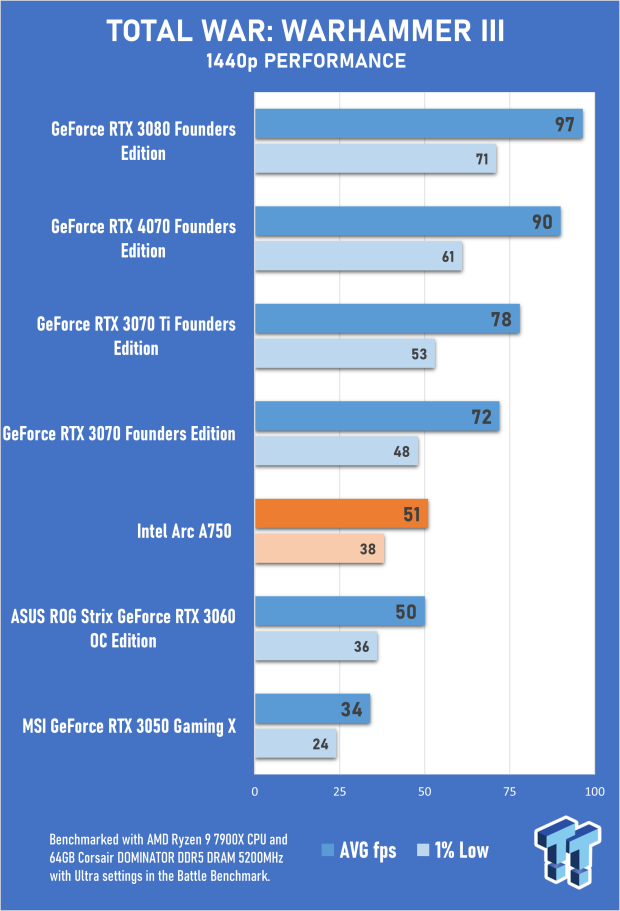
Benchmarks Summary, Ray-Tracing Performance, and XeSS
Across 15 games at 1080p and 1440p - we didn't include 4K numbers as the Intel Arc A750 sits in the same bracket as the GeForce RTX 3060 and GeForce RTX 3050 - it's safe to say that although the Intel Arc A750's performance was impressive and stable, it often fell below our expectations of it besting the RTX 3060 in every test.
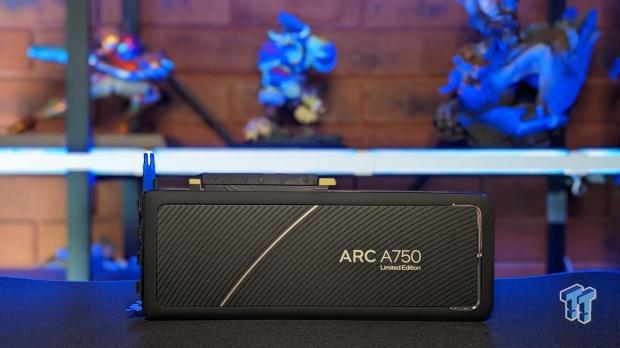
Results for titles like Assassin's Creed Odyssey and Rainbow Six Extraction sat below or closer to the GeForce RTX 3050, bringing the total average down. As every other result shows, the Intel Arc A750 consistently outperforms the RTX 3050 and goes head-to-head with the RTX 3060.
And then you've got Cyberpunk 2077 without RT enabled, a title that sees NVIDIA cards perform exceptionally well. Here the Intel Arc A750 beats the RTX 3060 regarding average frame rates, 1% lows, and even Intel XeSS performance compared to NVIDIA DLSS. Even though it's not supported in anywhere near as many titles, Intel XeSS looks excellent on the Intel Arc A750 - offering similarly impressive visual fidelity as DLSS super Resolution.
Final Thoughts
The Intel Arc A750 offers impressive 1080p and 1440p performance - similar to the GeForce RTX 3060 - at a lower price point. But it's inconsistent, with some games performing better than others. The good news is that for our testing, we didn't encounter any real crashes or weirdness with the drivers, outside of having to restart a few benchmarks here and there when it looked like things were stuttering for no reason in particular.
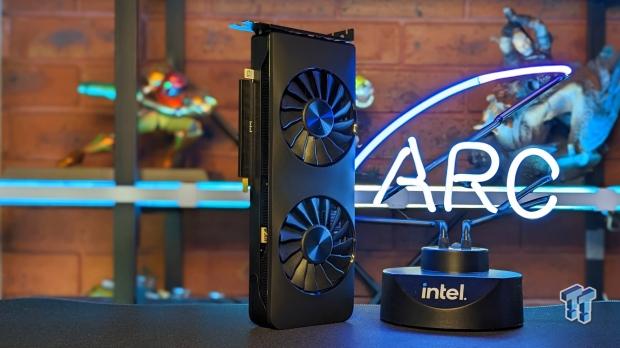
The interface and Arc Control stuff is simple and intuitive, with options to record and use the architecture's media features with simple controls. There are even performance overlays and other data readily available. It's also worth noting that the Intel Arc A750 requires Resizable BAR enabled to get the best results, which might limit the number of eligible machines it can effectively plug into - and that's worth considering if you're looking to upgrade an older machine. I only found that out when my system required a reboot because the Arc software said precisely that - for the best performance, you need to enable Resizable BAR.
More work is needed, but in May 2023, using the Intel Arc A750 is mostly a smooth and issue-free experience. And that's cause for celebration. Game performance is impressive and consistent in that 1% lows are all impressive - but it still falls short compared to the GeForce RTX 3060. As an entry-level GPU, it's worth considering, and with more mature drivers and game support, it points to a bright future for additional Intel Arc GPUs. Especially now as NVIDIA and AMD are prepping new mainstream options.

